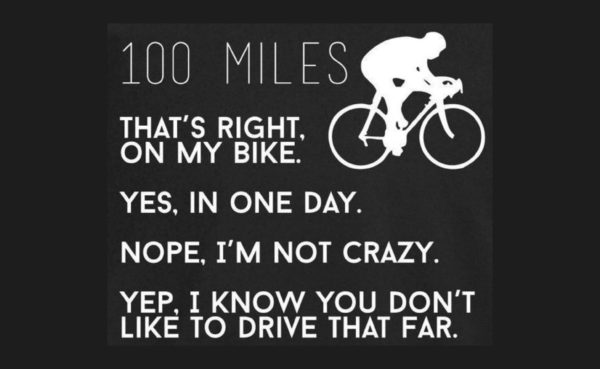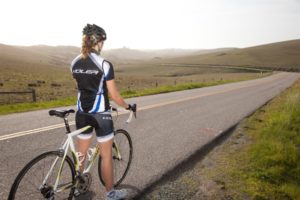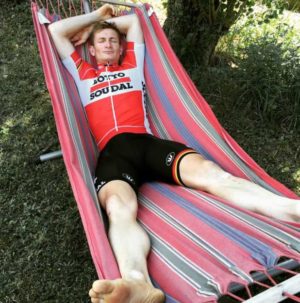Training for a century ride is a 100 mile (or 100km, a metric century) feat that many riders choose as one of their first cycling goals. There’s something about the number that just sounds big, exciting, and an accomplishment to complete. How many other people can say they did 100 of something? And not just something silly like steps or feet. Training for a century ride is the real deal. It’s something that as a cyclist, takes you to a higher level. It’s sort of like airline clubs where the elite have their own separate lounges to mingle with others like them.
The easy part about doing a century is deciding to do it. The hard part is getting ready for it and riding the century itself. This is what makes it elite. It’s not something you can just go out and do. You have to prepare as well as know what to do come the big day to get to that elite status of riding.

Training for a Century Ride
Preparation
A century is a long endeavour, not only on the day of the ride, but in preparation as well. It will take anywhere from four hours if you’re in a fast group, to ten hours. The riding in the weeks and months ahead must be constructed to arrive prepared not only to complete the ride, but to enjoy it as well. It’s not about just finishing but enjoying the journey along the way.
Presumably you are already riding on a somewhat regular basis and can ride anywhere from thirty to fifty miles without too much issue. If not, you should build to these numbers first and then continue building to a century. If you just go out and try to do big rides straight away, injury can result, as well as you having less fun doing the rides.
Bike Fit
The first thing to do before increasing your mileage substantially is to make sure you have a proper fit on your bike. This doesn’t have to be a full on bike fit but can rather be someone who has a bit of experience taking a look at your position.
The two main areas to focus on are saddle height (which determines how much knee bend you have) as well as saddle fore/aft position (which determines where your knee falls relative to your pedal). As long as these are good you have much less risk of an injury developing. Other things such as handle bar height and extension won’t have as much of an impact on your legs, which have the highest loads placed on them, but can impact your back and overall comfort. Make sure you have a good fit before you start riding more and more.
Training
The second thing to focus on is the riding itself. There are century training plans out there that can help ensure you are ready come the day of the ride but you don’t necessarily need one if you are diligent in your riding and know what rides to do and when. The biggest thing in preparing for 100 miles is to ride regularly. We would all love to ride long every day but that’s not always possible so fitting in a couple longer rides each week combined with shorter higher intensity rides along with a few rest days will accelerate your fitness.
Long Rides
Your long rides each week should build to nearly 100 miles two weeks before your ride. The week prior to your ride should be dialled back to arrive with peak fitness and rest. This means that, working backwards, you should have a ride each week totalling 90 miles, 80 miles, 70 miles, 60 miles, 50 miles, and so on, until you reach the rough amount of how long your long rides are now. This will give you a rough estimate of how much time you should allot to be fit enough for a century ride.
You need to add a week however for recovery after each third week. In general you should add no more than 10% each week to your riding total. As you can see it takes a considerable amount of time to build to a century ride. Your long ride should be done at a pace where you are sure you can complete the entire ride. Don’t go crazy on the climbs, and if you’re feeling depleted, dial it back a little, eat some food and drink, and hopefully your legs come back around.
Medium Rides
Typically one day on the weekends are reserved for a long ride and then the other day, ideally the second day, is used for a medium length ride. This should be about half, or a little more, of your long ride. This medium length ride should have a few periods of higher intensity, such as a handful of five, ten, twenty minute climbs or longer depending upon your areas terrain.
Go harder on these hills. Your effort level should be that of if you had to sustain it the rest of the ride, you couldn’t, but you can make it to the top of the hill with certainty. It’s not a max effort, just a higher than endurance pace effort. Do a few of these throughout the ride. If you don’t have any climbs around, simulate them by riding into a headwind if you can, and putting your bike into a bigger gear causing your cadence to slow. During the week you should do at least one other medium distance ride with the same efforts. These should not be done however the day before or after your weekend rides.
Short Rides
The day before your two day weekend block, or any other two days that work for you, should be a shorter, easier ride allowing your legs to recover but active enough to stay loose and keep the blood flowing for recovery. You should also have another ride like this early in the week. If you are pressed for time and can’t get in a medium length ride in during the week, doing a shorter higher intensity ride can be beneficial. Find a short climb, one to five minutes, and build to doing five to eight efforts on it close to your maximum. Don’t go all out as you won’t be able to do any more after, but you should still be going pretty hard. Give yourself five minutes of rest between each one.
 Off Days
Off Days
Depending upon your riding availability as well as your fitness level, you should have at least one rest day per week and more as needed. Ideally these are following your longer rides such as Monday after a weekend of riding. If you do have to ride to commute, take some extra time to do it and ride easy. If you can, do something that is still a bit active such as hiking or taking a walk. You don’t need to ride you just want to get the blood flowing.
Training for a century ride is quite the endeavour that with the proper preparation can be exhilarating to do and complete. Following it you will have much more confidence on all of your longer and challenging rides knowing that you’ve completed something harder and longer. All of the riding building up to the century will also help your riding overall as you will be able to do longer and perhaps bigger rides and events opening the door further into what cycling can bring. We always want everything now but building to your goals gives them a solid base that will not only help your cycling but your overall wellbeing.